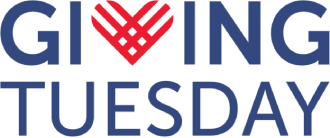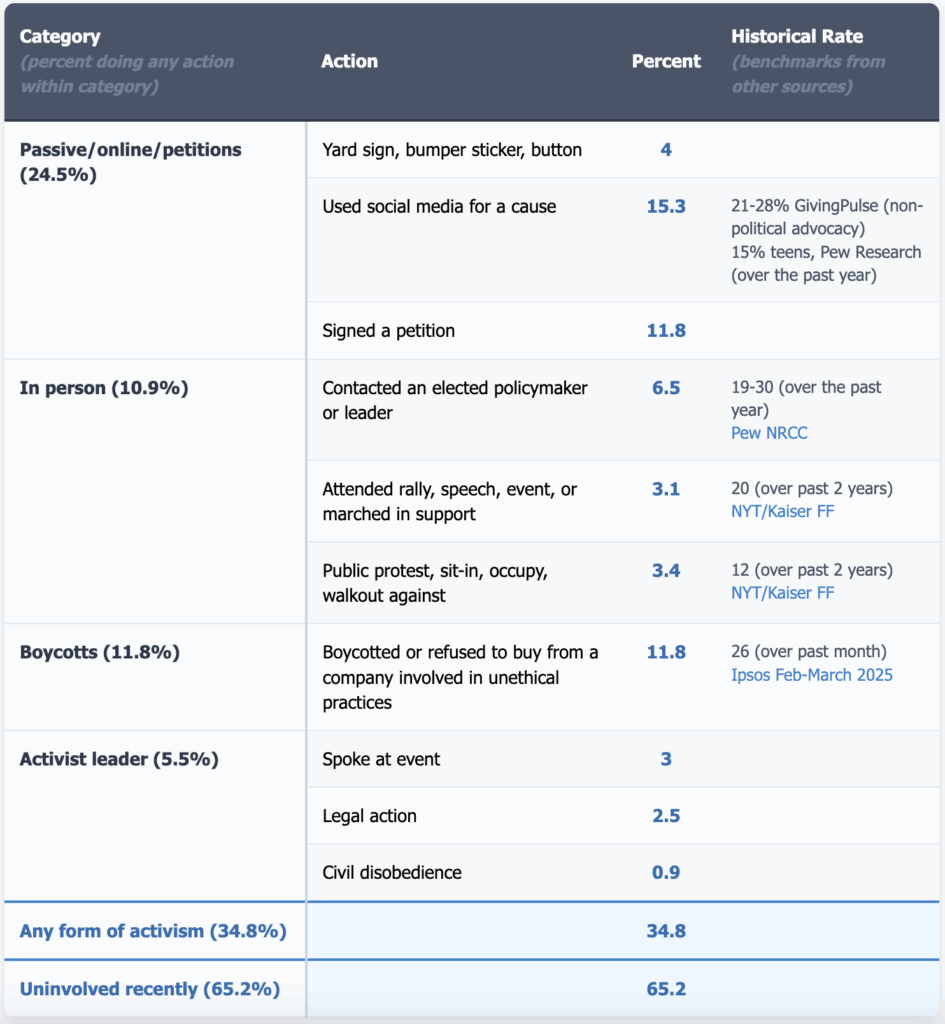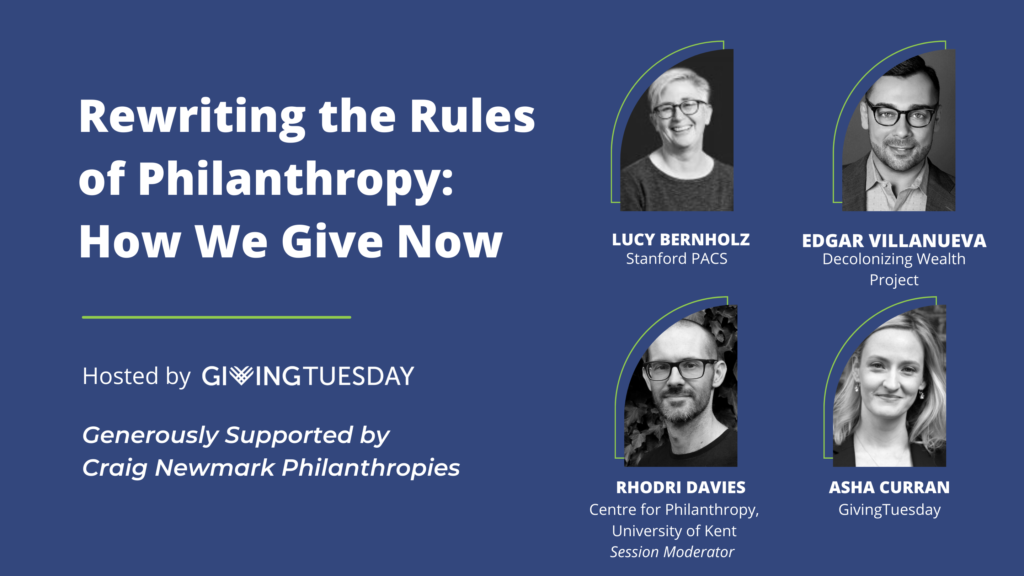The GivingTuesday Data Commons recently started tracking 10 forms of civic activism on a weekly basis through the GivingPulse survey, offering a detailed view into how people engage with causes beyond moments of crisis or election season.
The results? Activism, defined as a person who recently participated in either passive online, in-person, boycotts, and/or leading events is far more common than most may think, and the people who take action for causes are more likely to give, volunteer, and support their communities in other ways.
Over a third of the US population engaged in some form of activism in Q1 (January-March) 2025
These 10 activities broadly define a spectrum of activism, which have not been measured together in a weekly national survey before. For additional context, we’ve provided a recently reported rate for each action in addition to our Q1 findings. These data points represent findings from longer time periods than one quarter. Activities are grouped into four categories based on increasing levels of commitment: passive (signing petitions, posting yard signs, wearing buttons, advocating online), boycotts, in-person, and activism leadership. In Q1, just over a third of respondents reported participating in some form of activism within 7 days of being surveyed.
Rates of Activism
In Q1 2025, 35% of Americans said they engaged in some form of activism in the past week, with online/petition activism (24.5%) being most common, followed by boycotts (11.8%), in-person activism (10.9%), and activism leadership (5.5%). Both online and in-person activism are either at or above rates observed in previous research, while boycotts appear to be less prevalent. An Ipsos poll about boycotts during Q1 2025 found that about a quarter of the population had boycotted something over the past month, though these efforts might not be sustained, given that fewer people said they’d done this in the last 7 days in our survey.
How do activism and advocacy differ?
We ask people whether they engage in one or more of the 10 forms of activism and, separately, whether they have recently advocated around a specific cause (across 20 themes, such as human rights, climate, the arts, poverty, and more). We find significant overlap in the percentage of respondents who do both. Activists were 36% more likely than non-activists to have also advocated for a cause.
We also found that activists, as a group, were far more likely to favor informal generosity. Compared to non-activists, they supported individuals (+34)¹, informal groups (+32), and volunteered (+28). They also gave slightly more often to registered nonprofits (+25). Surprisingly, while activists are more likely to give money to a politician or political party (+16), they are less likely to engage in this way than through informal giving and volunteering.
Taken together, these findings suggest that activism is a component of advocacy that is less directly tied to political candidates and parties, and more likely to operate through informal networks for social change and justice-seeking. Activists also constitute a much larger proportion of the general population (33-38%) than those who make political donations (7%).
How activism relates to Civic Intent and other attitudes
Of all the attitudes we track, two stand out as being far more prevalent among activists than non-activists:
- Activists are far more likely to agree with the statement, “I strive to help those most in need, even if that means helping those from my community less.”
- Activists are also far more likely to say their decisions to help others often include input from family and/or others.”
In both cases, activists were 15-17 percent more likely than non-activists to agree with these statements. Activists also had higher Civic Intent scores (+9) than non-activists, and this increase in Civic Intent among activists was just as high for leaders as for those who engage online or passively.
It appears that all forms of activism are relevant to the community-minded identity that Civic Intent aims to capture. There is one notable exception: boycotts. People who engage in various other forms of activism tend to have higher Civic Intent, meaning they want to build community and have recently acted generously. Those who only engage in boycotting are no more or less likely to help others than those who don’t. To better understand this, we added ‘buycotting’ (deliberately supporting companies that reflect one’s values) as a separate category to track, as that may be more connected to Civic Intent than punishing brands.
We also found that people engage in activism at similar rates across the Pew political spectrum, though specific forms of activism will tend to appeal differently across different groups. In Q1 2025, 37% of people in left-leaning Pew types participated in some form of recent activism, compared to 29% of right-leaning Pew-types, and 31% of centrist groups.
Those who had recently advocated for a cause, helped a person, or volunteered recently were more likely to have engaged in activism than those who gave to a formal, registered non-profit or to a political candidate or group.
Why This Matters
These findings reveal a critical truth: activism and generosity are deeply connected. People who take action for causes, whether by signing a petition, joining a protest, or leading a community initiative, are far more likely to also give, volunteer, and help others.
For movements like GivingTuesday, this insight is powerful. Engaging people through causes they already care about doesn’t just drive a single campaign, it fuels an enduring culture of action and generosity. By treating activism as a pathway to giving, we can bridge advocacy and generosity, creating a stronger civic spirit year-round.
——————————————————————————————————————————————–
¹ +34: the percentage of activists that supported individuals was 34 percentage points higher than for non-activists.




